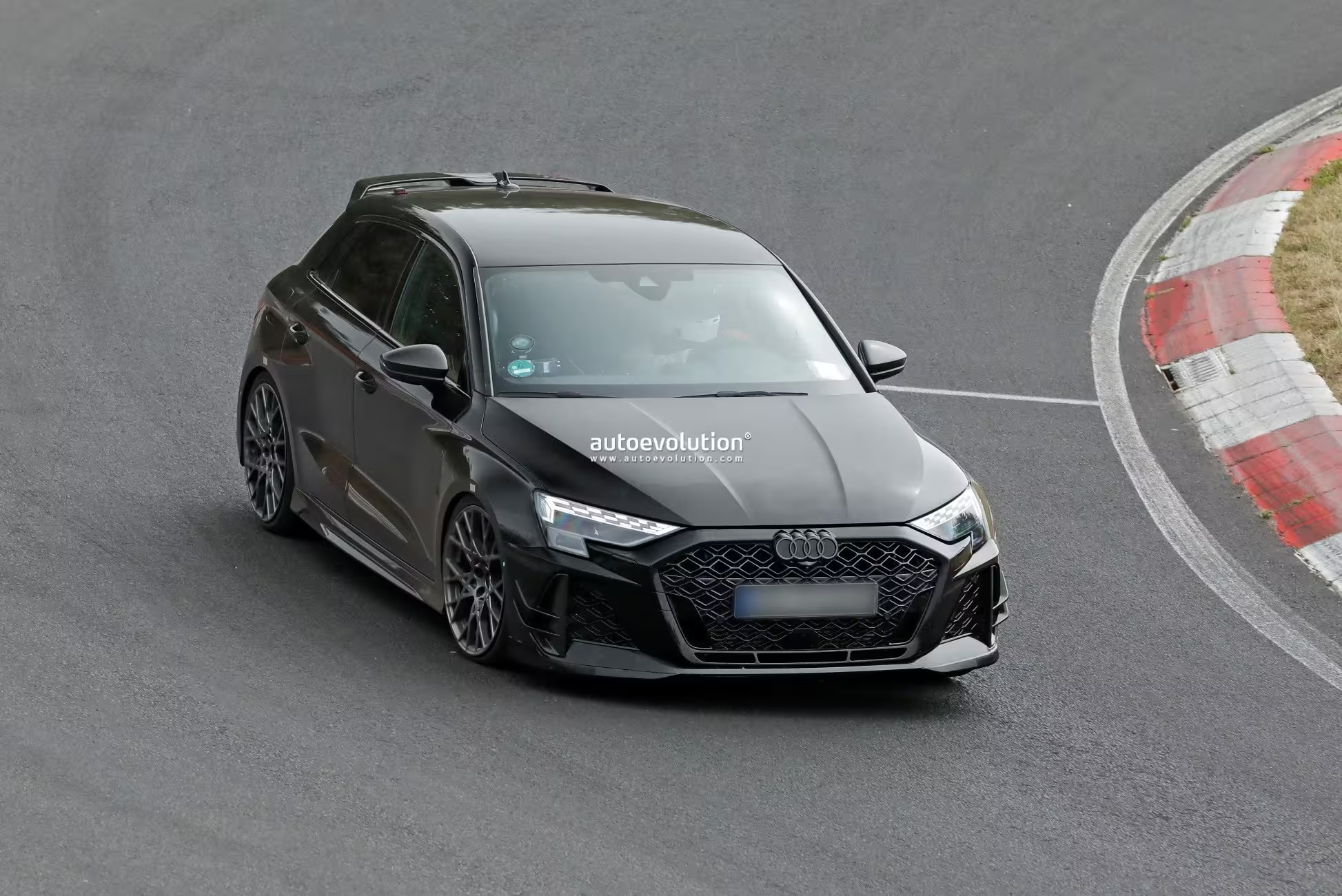4 Minutes
Audi RS 3 GT Makes Spy Photo Debut
Audi Sport appears to be preparing a dramatic finale for its iconic 2.5‑liter TFSI five‑cylinder. Spy photos from the Nürburgring's Green Hell show a heavily revised 2026 RS 3 GT prototype wearing aggressive aero, lightweight materials and hardware that suggests a more powerful, sharper driving compact performance car.
Design & Aerodynamics
The photographed black prototype shows clear track-focused upgrades: pronounced front bumper canards, a reshaped front splitter and a distinct roof‑mounted spoiler. Large, aggressive wheels reveal big ventilated rotors with blue calipers, while visible carbon fiber panels hint at targeted weight savings. These cues signal a vehicle tuned for higher downforce and improved cooling—key for repeated hot‑lap durability.
Performance & Powertrain
Under the hood, the RS 3 GT is expected to retain Audi’s celebrated 2.5‑liter TFSI inline‑five—known internally as the EA855—at least for this final, high‑performance chapter. U.S. RS 3 Sedan specs for 2026 list 394 hp and 369 lb‑ft (roughly 500 Nm for European models where the Sportback is rated at 400 PS and 500 Nm). The most potent factory RS 3 to date produces 407 PS (401 hp), so Audi Sport is likely targeting north of 400 hp for the GT, with speculation of 416+ hp to eclipse rivals such as the Mercedes‑AMG A 45 S and its potent 2.0‑liter turbo four‑cylinder.

Engine Details
The EA855 2,480 cc five‑cylinder has been a hallmark of Audi's performance compact line since its 2009 debut. The block uses compacted vermicular graphite cast iron for rigidity and durability; the EVO iteration trims roughly 26 kg (57 lb) from the original package—helpful for power-to-weight and handling balance.
Chassis, Handling & Brakes
The spy shots suggest retuned steering for sharper turn‑in and a revised suspension setup to handle extra power and higher lateral loads. Large brakes and multi‑spoke track wheels imply improved fade resistance for circuit work. Expect bespoke chassis tuning, firmer anti‑roll bars and upgraded dampers compared with the standard RS 3 to deliver more confident cornering and faster lap times.
Market Positioning & Price
Even in standard form, the RS 3 sits at the premium end of compact performance cars: U.S. pricing starts at about $66,100 for the sedan, while the Germany‑spec Sportback begins near €66,000. The RS 3 GT—if it serves as a swansong for the five‑cylinder—will almost certainly command a substantial premium. Beyond performance, limited availability and collectibility could make the GT an instant classic among enthusiasts.

Comparisons & Legacy
Compared with rivals like the AMG A 45 S (2.0‑liter turbo) and previous Audi Sport models such as the RS Q3 and TT RS, the RS 3 GT aims to emphasize the unique character of the five‑cylinder: its distinctive sound, broad torque curve and compact packaging. If Audi extracts 416+ hp, the GT would not only be the most powerful factory RS 3 but also a symbolic farewell to an engine architecture that traces its rally roots to the Quattro era.
Summary
The 2026 Audi RS 3 GT spy shots point to a focused, limited‑run performance model designed to showcase the last hurrah of the 2.5‑liter TFSI. With aerodynamic upgrades, lightweight carbon parts, tighter chassis tuning and expected power increases above the 400 hp mark, the GT will be positioned as a high‑end, track‑capable compact performance car aimed squarely at enthusiasts and collectors.
Source: autoevolution


Leave a Comment